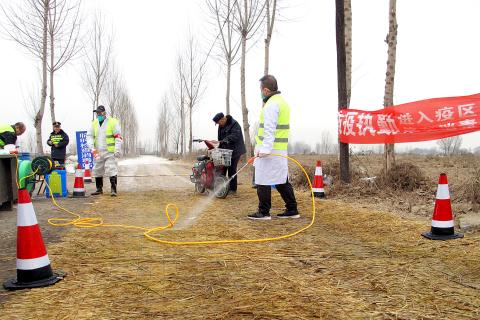As many as half of China’s breeding pigs have either died from African swine fever or been slaughtered because of the spreading disease, twice as many as officially acknowledged, according to the estimates of four people who supply large farms.
While other estimates are more conservative, the plunge in the number of sows is poised to leave a large hole in the supply of the country’s favorite meat, pushing up food prices and devastating livelihoods in a rural economy that includes 40 million pig farmers.
“Something like 50 percent of sows are dead,” said Edgar Wayne Johnson, a veterinarian who has spent 14 years in China and founded Enable Agricultural Technology Consulting, a Beijing-based farm services firm with clients nationwide.

Photo: Reuters
Three other executives at producers of vaccines, feed additives and genetics also estimate losses of 40 to 50 percent, based on falling sales for their companies’ products and direct knowledge of the extent of the deadly disease on farms across the country.
Losses are not only from infected pigs dying or being culled, but also farmers sending pigs to market early when the disease is discovered nearby, farmers and industry insiders have said, which analysts say has kept a lid on pork prices in recent months.
However, prices began rising substantially this month and the Chinese Ministry of Agriculture and Rural Affairs has said they could surge by 70 percent in coming months as a result of the outbreak.
China, which produces half the world’s pork, last month said its sow herd declined by a record 23.9 percent in May from a year earlier, a slightly deeper drop than for the overall pig herd.
Sows, or adult females bred to produce piglets for slaughter, account for about one in 10 pigs in China. A decline in the sow herd usually equates to a similar drop in pork output, industry experts say.
The ministry on Monday last week said the disease has been “effectively controlled,” Xinhua news agency reported.
Dutch agricultural lender Rabobank said in April that pork production losses from China’s African swine fever outbreak could reach 35 percent.
It is revising that number higher to account for widespread slaughtering in recent months, senior analysts Pan Chenjun (潘晨軍) said.
Since China’s first reported case in August last year, it has spread to every province and beyond China’s borders, despite measures taken by Beijing to curb its advance.
The government has reported 137 outbreaks so far, but many more are going unreported, most recently in southern provinces such as Guangdong, Guangxi and Hunan, according to four farmers and an official recently interviewed by Reuters.
“Almost all the pigs here have died,” said a farmer in Guangxi’s Bobai County.
“We were not allowed to report the pig disease,” the farmer said, declining to reveal her name because of the sensitivity of the issue, adding that authorities have detained farmers for “spreading rumors” about the disease.
Authorities in Yulin, which oversees Bobai County, confirmed an outbreak of the disease in one pig on May 27.
Reuters also spoke to farmers in the cities of Zhongshan, Foshan and Maoming in Guangdong Province, all of whom had lost hundreds or thousands of pigs to the disease in the last three months.
No outbreaks have been officially reported in those cities.
China had 375 million pigs at the end of March, 10 percent fewer than at the same time a year ago, and there were 38 million sows, an 11 percent drop, China’s National Bureau of Statistics (NBS) said.
Numerous suppliers to the industry have said they believe the actual decline is much worse.
Dick Hordijk, chief executive at Royal Agrifirm, last month told Dutch radio station BNR that his firm’s profits in China would be wiped out by the disease, which was spreading like “an oil slick.”
“One hundred percent of our business was focused on pigs, half of it is now gone,” he said. “That’s a disaster for the farmers and the animals.”
Johnson said the virus is so widespread that he has detected it on the surface of a highway in the province, where it can be spread by passing trucks.
He said he used the same test that is widely used to detect the virus in pigs.

SECURITY: As China is ‘reshaping’ Hong Kong’s population, Taiwan must raise the eligibility threshold for applications from Hong Kongers, Chiu Chui-cheng said When Hong Kong and Macau citizens apply for residency in Taiwan, it would be under a new category that includes a “national security observation period,” Mainland Affairs Council (MAC) Minister Chiu Chui-cheng (邱垂正) said yesterday. President William Lai (賴清德) on March 13 announced 17 strategies to counter China’s aggression toward Taiwan, including incorporating national security considerations into the review process for residency applications from Hong Kong and Macau citizens. The situation in Hong Kong is constantly changing, Chiu said to media yesterday on the sidelines of the Taipei Technology Run hosted by the Taipei Neihu Technology Park Development Association. With

CARROT AND STICK: While unrelenting in its military threats, China attracted nearly 40,000 Taiwanese to over 400 business events last year Nearly 40,000 Taiwanese last year joined industry events in China, such as conferences and trade fairs, supported by the Chinese government, a study showed yesterday, as Beijing ramps up a charm offensive toward Taipei alongside military pressure. China has long taken a carrot-and-stick approach to Taiwan, threatening it with the prospect of military action while reaching out to those it believes are amenable to Beijing’s point of view. Taiwanese security officials are wary of what they see as Beijing’s influence campaigns to sway public opinion after Taipei and Beijing gradually resumed travel links halted by the COVID-19 pandemic, but the scale of

A US Marine Corps regiment equipped with Naval Strike Missiles (NSM) is set to participate in the upcoming Balikatan 25 exercise in the Luzon Strait, marking the system’s first-ever deployment in the Philippines. US and Philippine officials have separately confirmed that the Navy Marine Expeditionary Ship Interdiction System (NMESIS) — the mobile launch platform for the Naval Strike Missile — would take part in the joint exercise. The missiles are being deployed to “a strategic first island chain chokepoint” in the waters between Taiwan proper and the Philippines, US-based Naval News reported. “The Luzon Strait and Bashi Channel represent a critical access

Pope Francis is be laid to rest on Saturday after lying in state for three days in St Peter’s Basilica, where the faithful are expected to flock to pay their respects to history’s first Latin American pontiff. The cardinals met yesterday in the Vatican’s synod hall to chart the next steps before a conclave begins to choose Francis’ successor, as condolences poured in from around the world. According to current norms, the conclave must begin between May 5 and 10. The cardinals set the funeral for Saturday at 10am in St Peter’s Square, to be celebrated by the dean of the College